Barbara Ross's Blog, page 12
March 13, 2017
Why I’ll Stop Reading a Long-Running Mystery Series
NEWS flash: Ginny JC is the winner of Wendy Tyson’s audio book. Ginny, please check your email!
by Barb, traveling back to Key West after a lovely wedding in Vermont
As I explained on Maine Crime Writers on Thursday, as soon as I turn in my current book, it will be time to write a new proposal for books seven through nine of the Maine Clambake Mysteries. This got me thinking about the positive reasons why I stay with a long-running mystery series. I wrote my answers here.
In my post today, I’m looking at the opposite side of the question. What causes me to drift away from a series? I don’t mean read one book and decide,”This isn’t for me.” I mean to either consciously or unconsciously stop reading new books in a mystery series I’ve previously been invested in.
Here’s what I came up with.
[image error](1) I don’t care what happens to anyone. There are a lot of discussions, most of them not fruitful in my opinion, about whether main characters have to be “likeable.” For me, the answer is no. I don’t have to like them, but a do have to care what happens to them, because the entire point of reading a book is to find out what happens to them. There may be some standalone thrillers with plots so compelling you’ll read them in spite of the cardboard characters, but that isn’t possible for a series.
While this might seem like a reason not to start reading a series in the first place, I have often started series with interesting characters only to have them turn into people I wouldn’t want to share a cab with, much less get stuck on a desert island with. Patricia Cornwall’s Kay Scarpetta series became this for me. I wasn’t put off by the blood and gore, or the marital infidelity per se, or even the crazy politics. But a main character making terrible life decisions, sitting in judgey-judgment on all the other characters, who are also making terrible life decisions… It was too much. I let it go.
[image error](2) The series story doesn’t move forward. There’s a lot of talk about whether protagonists in crime series need a character arc. Whether they need to somehow be different at the end of a book than they are at the beginning. Whether they need to grow over a series. Lee Child’s Jack Reacher famously doesn’t.
I find I don’t care so much if the character changes, but I need the story to move forward. I need the character to choose the good guy or the bad boy, to make peace with her mother or decide she never will. I need the hints about that thing that happened in the past to be revealed if not resolved. I’m really patient. Milk it for as many books as you think you can, but I need it to happen.
Janet Evanovich’s Stephanie Plum series was this for me. I loved the humor and I loved the portrait of life in the Burg. But it all became a little rote–sassy dialog, car crash, fail to make choice between two men, crash funeral with grandma, car cash, car cash. She made a lot of money off of me. I took this series for a long ride, but eventually I gave up.
[image error](3) Every single character from every single book moves forward with the series. I like the introduction of interesting new series characters, especially if they have a personal or professional connection to the main character. But I don’t need every character I’ve ever met, many of whom I can’t remember, to be involved in each new investigation.
I stopped reading Martha Grimes’ Richard Jury series for this reason. When there got to be dozens of characters, all introduced in the first chapter of the next new book, I gave up.
(4) There are too many books, too frequently. Okay, I know this is idiosyncratic to me and that the only viable business model for a lot of self-published series right now involves frequent releases. It may be because I read slowly, or I have reading I have to do for my writing, or I have so many favorite series, but if an author writes so much that I get way far behind, I’ll give up.
Readers, what makes you stop reading new books mystery series?
Save
Save
Save
Save
Save
Filed under: Barb's posts Tagged: Janet Evanovich, Martha Grimes, Patricia Cornwell

February 13, 2017
Island Time
by Barb, suffering the indignities of a WIP that isn’t jelling.
Hi All. I’m still in Key West. The weather has been uncommonly good this year and we’ve been enjoying our time. But the work in progress on my desk takes place on a different island, in a different climate, at a different time of year.
Stowed Away, the sixth Maine Clambake Mystery, brings the Snowden Family saga full cycle. It’s spring again, and Julia and her relatives are preparing Morrow Island for the tourist season. When I started Clammed Up, I knew about the Cabbage Island Clambake, but I had never been there. Over a long, snowy winter, while I waited for the real clambake to open, I consciously created my own island. I wanted my island to be different, in part to meet some story needs, and in part to distinguish it from any comparison to the real island because of the entirely fictional events that would take place there.
I carefully considered how many acres it would be, how high it would be (since the abandoned mansion Windsholme sat at it’s highest spot), and how far out to sea it was. There are 4400 islands along the Maine coast, so I had plenty of bases for comparison. I studied websites and Google images, judging the terrain.
[image error]Then, years after that work was done and committed to Morrow Island lore, a friend sent me a link about an island for sale, Clapboard Island West, 22 acres with a 9087 square foot home, lots of out buildings, including a tea house and a guest house, and a little beach. For a cool $4.5 million it can be yours. (Be sure to negotiate, it’s been on a the market for awhile.)
Or, you can do what I do, and ogle the photos, descriptions, and the two videos available about the historic house and island.
Of course, there are differences between Clapboard and Morrow Island. The biggest is geographic. Clapboard Island is off Falmouth, Maine in Casco Bay. My fictional island is about an hour and a half farther north. Clapboard Island is slightly larger than Morrow Island and not as high. Morrow Island gets its fresh water and electricity from mid-May to Columbus Day in great conduits that come from the town. Clapboard Island has an interesting aquifer and a solar plant for power. But really, if I’d moved Clapboard Island to where I needed it, and built a pavilion for dining, a kitchen, and a gift shop, it would have done fine.
Sometimes I really wonder why I spend so much time making this stuff up.
Readers: Have you ever imagined a place and then found an incarnation that was real or nearly so? For those who’ve read the Maine Clambake Mysteries–what do you think? Does Clapboard Island match your mental image or is it markedly different?
Save
Save
Save
Save
Save
Save
Filed under: Barb's posts Tagged: Cabbage Island Clambake, Clapboard Island, maine clambake mysteries, Morrow Island

January 9, 2017
Ma’s Ginger Snaps from Iced Under
by Barb, barefoot and just out of the pool in Key West (don’t hate me), but writing this post for my friends up north
[image error]Iced Under, the newest Maine Clambake Mystery, takes place in the dead of a Maine winter. In the book, Julia Snowden’s mother, Jacqueline, bakes these cookies with her granddaughter Page to keep her entertained on a snowy day. In reality, these are cookies my grandmother made.
From the book–
When my cousins get together, one memory we all share is my grandmother’s ginger snaps. It was a joy to find them in your mailbox at camp, or on a bluesy day in your college dorm. They always came in a coffee can, lined on the inside with wax paper and taped shut. The cookies provided instant comfort and could be hoarded or shared, depending on your mood.
[image error]Ingredients
1½ sticks butter, melted
2 cups granulated white sugar
¼ cup molasses
1 egg, beaten lightly
2 cups flour
1 teaspoon baking soda
½ teaspoon ginger
¼ teaspoon each cloves, allspice, nutmeg, mace
1 teaspoon cinnamon
½ teaspoon salt
Instructions
Mix the melted butter, 1 cup of the sugar, and the molasses. (Put aside the remaining cup of sugar.) When the mixture is cool, fold in the lightly beaten egg. In another bowl, mix the flour, baking soda, ginger, cinnamon, salt, cloves, allspice, nutmeg, and mace. Add the dry ingredients to the wet. Mix thoroughly with a mixer or food processor.
Dough will form itself into a ball. Wrap in plastic wrap and put into refrigerator for at least 4 hours or overnight.
Shape cold dough into balls using a small melon baller. Roll the balls in sugar to coat completely. Place the balls at least 2 inches apart on parchment paper on a cookie sheet, to allow for expansion.
Bake in a preheated oven at 350 degrees for 10 to 12 minutes.
Enjoy!
Readers: Do you have a favorite recipe for an inclement day? Tell us what it is!
Save
Filed under: Barb's posts Tagged: Maine Clambake Mystery, recipe

December 29, 2016
The Frozen Water Trade
by Barb somewhere between Wilkes-Barre, Pennsylvania and Roanoke Rapids, North Carolina as you read this
[image error]The fifth Maine Clambake Mystery, Iced Under, debuted this week. In it, I try to fill in some of the blanks in Julia’s mother’s family history.
Pieces of Jacqueline Snowden’s story have been told in each of the Maine Clambake Mysteries. From the previous books, we know she lost her mother young, that she inherited Morrow Island, and that her once-wealthy ancestors build Windsholme, the abandoned mansion on the island. What I’ve never told is how her family made their money and how they lost it.
I’ve known for a while that the Morrows made their money in the frozen-water trade. The idea that New Englanders, in the early part of the nineteenth century, shipped ice halfway around the world has long fascinated to me. In researching the story of the ice trade, I found not one, but two amazing stories.
[image error]
Frederic Tudor
Frederic Tudor was the originator of the ice trade. As early as 1805 he had the idea that ice cut from ponds in Massachusetts could be shipped to the West Indies for the enjoyment of the colonists there. Literally everyone he knew in Boston thought this was crazy. In the years that followed he experimented with different types of insulation (sawdust turned out to be best) and set about getting exclusive contracts to sell the ice in tropical cities. It took much time, the purchase of ships had to be financed, ice houses had to be built at his destinations. The War of 1812 set back the calendar. He went to debtors prison twice for debts accrued pursuing the venture. However, by 1826 Tudor was at last making a fortune, harvesting ice from Fresh Pond in Cambridge, Massachusetts, and sending it to Cuba, Haiti, New Orleans, Savannah, and Calcutta. Henry David Thoreau awoke one morning to see sixty men and teams of horses cutting ice on Walden Pond. Though he hated the intrusion, Thoreau was taken with the idea that water he had bathed in would end up in India. The frozen water trade was a genius business because ships often came to Boston with coffee and other goods from around the world and left empty, with granite boulders used a ballast. New England had no cash crop and little in the way of natural resources. The ice was free, except for the labor, and it came every year.
[image error]Tudor’s family life was somehow even more colorful than his business. At fifty, he married for the first time, a woman thirty years his junior and went on to have six children. We know as much as we do about his business because all his diaries reside at the library at Harvard Business School. After he died at the age of eighty-one, his wife went through the diaries, editorializing. The theme of her complaints was that he was “relentless.” Tudor’s sister had an affair with Joseph Bonaparte, ex-King of Spain, when both lived in New Jersey (because, of course…). His niece was the mother of the Irish Nationalist Charles Stewart Parnell. One of his descendants was one of my favorite New England author/illustrators, Tasha Tudor.
[image error]I borrowed a good deal of Frederic Tudor’s history for Jacqueline’s ancestor Frederic Morrow. Two excellent books about Frederic Tudor are The Ice King: Frederic Tudor and His Circle, by Carl Seaburg and Stanley Patterson (Massachusetts Historical Society and Mystic Seaport, 2003), and The Frozen-Water Trade: A True Story, by Gavin Weightman (Hyperion, 2003).
The end of the ice trade is as interesting as the beginning and brings us another fascinating character, Charlie Morse of Bath, Maine. By the time Charlie got into the ice business in 1897, it was no longer necessary to ship ice to exotic places. Rural people and immigrants had poured into America’s cities and ice was need to preserve food and cool off from hard, physical work. New York City alone consumed four million pounds of ice a day.
[image error]Charlie Morse had rights to cut ice along the Kennebec River in Maine. He had the Tammany connections in New York City to shut out his competitors, leaving their ships unloaded in New York harbor. But he took it too far, jacking up the price so high one summer, the press declared it a war on the poor, and eventually Charlie went to prison. He was a rogue and a speculator, just like Frederic Tudor, and he, too, was called “The Ice King.” He also had a colorful and crazy personal life.
I appropriated some of Charlie’s deeds for Jacqueline’s ancestor William Morrow. If you want to learn more, I recommend Bath, Maine’s Charlie Morse: Ice King & Wall Street Scoundrel, by Philip H. Woods (The History Press, 2011).
The ice trade was eventually done in by modern refrigeration. The age of the Ice Kings had ended, and though great fortunes were made and lost, it had lasted less than one hundred years.
I love stuff like that–those moments in time that seem so important with empires built like they’ll last forever–and then, “poof” they are gone. The stories I wrote about Jacqueline’s ancestors are ultimately fiction, but they are rooted in history. Unfortunately, because it’s a small part of Iced Under, I could barely scratch the surface of this fascinating business and the larger-than-life characters behind it. I hope the book inspires some readers to learn more.
Save
Save
Filed under: Barb's posts Tagged: Charlie Morse, Frederic Tudor, Iced Under, Maine Clambake Mystery

November 14, 2016
Eggnog Murder–the Real Story Behind the Story
by Barb, who just finished making her famous (in small, exclusive circles) mincemeat. The holidays must be coming.
 The Wicked Cozy Authors’ Thankful for Our Readers month continues. Leave a comment on this blog post to win a copy of Eggnog Murder, along with a Snowden Family Clambake tote bag.
The Wicked Cozy Authors’ Thankful for Our Readers month continues. Leave a comment on this blog post to win a copy of Eggnog Murder, along with a Snowden Family Clambake tote bag.
++++
When my agent called me to say that “Kinda out of the blue,” Kensington had asked me to contribute a novella to a collection called Eggnog Murder, I was thrilled. My novels are always too short and my short stories always too long, so I suspected novellas were my true calling.
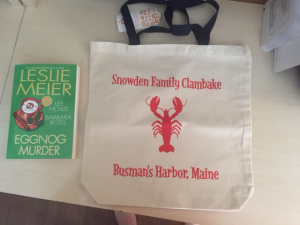
Today’s giveaway
But another reason I was pumped was because I had been sitting on a gem of an eggnog anecdote for almost thirty years.
To wit:
Many moons ago, when I was a young manager, I interviewed an even younger woman for a sales position. This is how it went.
Me: “And why are you considering leaving your current position?”
Interviewee: “Well, I kind of food poisoned every person in my company and all their guests at the office Christmas party.”
Me: (mouth open, no sounds coming out)
Interviewee, continuing: “My mother has this great recipe for eggnog. She makes it every year for our holiday open house. But something went wrong. The eggs were bad. Everyone was throwing up, and…” (ominous pause) “…worse.”
Me: “Oh, my God. Were you fired?”
Interviewee: “No, but once you’ve been in the ER, hooked up to an IV, being re-hydrated, next to your boss, and your boss’s boss, I figure you really don’t have much of a future with the company.”
Me: “You’re hired!”
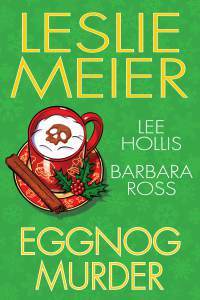 Actually, I didn’t hire her on the spot. We did the usual reference checks, etc. But I knew in that moment that I wanted to hire her. As one of my mentors had taught me well, you should always hire employees who are “pre-disastered.”
Actually, I didn’t hire her on the spot. We did the usual reference checks, etc. But I knew in that moment that I wanted to hire her. As one of my mentors had taught me well, you should always hire employees who are “pre-disastered.”
In John Irving’s The World According to Garp, Garp and his young wife are standing on the front lawn looking at a house for sale when a small plane flies straight into it. Garp turns to his wife and says, “We’ll take the house. Honey, the chances of another plane hitting this house are astronomical. It’s been pre-disastered. We’re going to be safe here.”
Of course, as Garp learns, having survived one kind of disaster does not prevent another. And so it is with employees. Pre-disastered doesn’t mean they’ve gotten their disaster “over with.” It means that having survived one, they know what to do. Tell the people who need to know immediately, honestly and completely. Ask for help. Treat the situation like a problem to be solved. Not, hope it will blow over, hope no one will notice, try to solve it by yourself until it gets even bigger. That sort of thing.
So, the action in my novella, “Nogged Off,” kicks off when Julia finds out her young subtenant has brought her mama’s eggnog to the office holiday party, and….
Readers: Have you been “pre-disastered” at work? Tell us about it in the comments, or otherwise just leave a comment for a chance to win.
Save
Save
Save
Save
Save
Save
Save
Filed under: Barb's posts Tagged: John Irving, pre-disastered, the world according to garp

October 25, 2016
Writing Novellas–Introducing Eggnog Murder
by Barb, slipping into a holiday mood early this year
 Today is release day for Eggnog Murder in hardcover, ebook and audiobook. The large print edition is coming in early December. Eggnog Murder is getting some great reviews, including a starred review from Publishers Weekly!
Today is release day for Eggnog Murder in hardcover, ebook and audiobook. The large print edition is coming in early December. Eggnog Murder is getting some great reviews, including a starred review from Publishers Weekly!
The book is a collection of three holiday novellas set in Maine. The other stories are by well-known cozy authors Leslie Meier and Lee Hollis. So, while yes, my story is about Julia Snowden, and it does take place chronologically between Fogged Inn and Iced Under; it’s a novella, not a novel.
What is a novella? Kensington defines them as between 25,000 and 35,000 words, or one third to half the length of a typical cozy. I thought it might be fun today to ask the authors what writing a novella was like and how they approached the task.
 Leslie Meier is the New York Times bestselling author of over twenty Lucy Stone mysteries and has also written for Ellery Queen’s Mystery Magazine. She is currently at work on the next Lucy Stone mystery. Readers can visit her website at www.LeslieMeier.com. Leslie’s novella is titled “Eggnog Murder.”
Leslie Meier is the New York Times bestselling author of over twenty Lucy Stone mysteries and has also written for Ellery Queen’s Mystery Magazine. She is currently at work on the next Lucy Stone mystery. Readers can visit her website at www.LeslieMeier.com. Leslie’s novella is titled “Eggnog Murder.”
Leslie: Because I tend to write short, I enjoy writing novellas. They’re more satisfying than a short story, because you can do more with character development and plot, and because they’re shorter than novels, you can move things along at a brisk pace. You can pack a lot into a novella, and you don’t have to muck about with all those descriptions of people and settings. In fact, it’s almost as if you can leave out the stuff that most readers just skip anyway!
I don’t really have any advice for writing a novella, but I can tell you what I do. I always outline my books, and for a novel I build my outline with 20 chapters. For a novella, the outline is for 10 chapters. That said, I can’t say that they actually take much less time to write, because the shorter work needs to be tighter and often needs some heavy revision. So if I have any advice, it’s to take time to revise and polish up that novella and make every word work.
 Lee Hollis is the pen name for a brother and sister writing team. Rick Copp is a veteran film and television writer/producer and also the author of two other mystery novel series. He lives in Palm Springs, California. Holly Simason is an award-winning food and cocktails columnist living in North Carolina. You may visit their website at www.LeeHollisMysteries.com. Lee’s story is titled, “Death by Eggnog.”
Lee Hollis is the pen name for a brother and sister writing team. Rick Copp is a veteran film and television writer/producer and also the author of two other mystery novel series. He lives in Palm Springs, California. Holly Simason is an award-winning food and cocktails columnist living in North Carolina. You may visit their website at www.LeeHollisMysteries.com. Lee’s story is titled, “Death by Eggnog.”
Holly (one half of the team behind author Lee Hollis): Writing a novella for Eggnog Murder was great fun in my opinion. First of all we were so excited to be asked to contribute a story to Eggnog Murder with Leslie Meier and Barbara Ross that I’m not even sure that I knew what we were writing for a couple of days!
We love using the holidays in our books so this was already a great beginning for us. We basically used the same process writing the novella as we do writing our Hayley Powell Food and Cocktail Mystery series except this time we were given the murder weapon “eggnog” so we checked that off our list.
Rick is always thinking ahead and when he knows what the title will be he already has an idea forming in his head about how the story will go. Then my favorite part is when we decide who will be murdered and who the murderer will be. Rick has the best imagination and comes up with great murder plots. I, on the other hand, am so food and cocktail obsessed that as soon as we have our plot I start scouring my recipes because we like the recipes to go along with our storyline or the season that it is set in.
I found that writing a novella was a bit easier than writing novel length because it was just a shorter version of the stories we all ready write. I have a tendency to go on and on when I write so writing a novella helped me choose my words more carefully and try to come to the point a bit quicker then usual.
This was a wonderful opportunity for us and I’m just keeping my fingers crossed that we can do another holiday novella with these two authors again very soon. Hey, Easter is right around the corner and I love chocolate and have some wonderful chocolate recipes.
 Barbara Ross: My story is titled, “Nogged Off.” I was excited about writing a novella because my novels are always too short and my short stories are always too long. I realized right away that I needed to think about structure. Was I going with a traditional mystery novel structure, with a victim, a pool of suspects and an investigation, or was I going more with a short story structure–a setup and a twist? I decided on short story structure because I thought it would be more fun.
Barbara Ross: My story is titled, “Nogged Off.” I was excited about writing a novella because my novels are always too short and my short stories are always too long. I realized right away that I needed to think about structure. Was I going with a traditional mystery novel structure, with a victim, a pool of suspects and an investigation, or was I going more with a short story structure–a setup and a twist? I decided on short story structure because I thought it would be more fun.
Because it was the holidays, I wanted to tale to be a little lighter and wackier than my Clambake mysteries tend to be, but nonetheless to include a murder and its consequences. I don’t outline, but I had a great starting point, a fabulous eggnog story someone had told me years ago. (More on this in a future blog post.) I started writing and hoped the length would be right. In the end it was and I really loved writing a novella.
Readers: How about you? Do you like novellas and the prospect of sampling multiple authors in one collection, or do you prefer to stick to novels?
Save
Save
Filed under: Barb's posts, Book Birthday Tagged: Death by Eggnog, Eggnog Murder, Hayley Powell Food and Cocktail Mysteries, Lee Hollis, leslie meier, Lucy Stone Mysteries, maine clambake mysteries, Nogged Off

September 12, 2016
Report from New Orleans
by Barb, at the New Orleans Marriott
My husband, Bill, and I came to New Orleans early to take advantage of the hotel conference rate to do a little touristing.
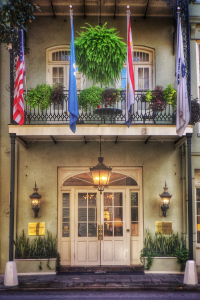 First News: We have a time and a place for the Cozy Meetup at Bouchercon– 12:00 noon Friday in the large lobby bar at the Marriott. Meet at the tables outside the Starbucks entrance. Bouchercon is so big, the point of the meetup is to provide cozy authors and fans with a rallying point to make sure we get to see one another other. People may drop by before they go to lunch, or may form lunch groups there, or may grab something from Starbucks, Urban Kitchen, or the Lobby Bar at the Marriott and hang out. We’re low-keying it. It is the Big Easy after all. We’d love to see you. All the Wicked Cozys will be there except Jessica Estevao who will be with us on a stick. Please pass the invite along to any cozy authors or readers who’ll be in New Orleans.
First News: We have a time and a place for the Cozy Meetup at Bouchercon– 12:00 noon Friday in the large lobby bar at the Marriott. Meet at the tables outside the Starbucks entrance. Bouchercon is so big, the point of the meetup is to provide cozy authors and fans with a rallying point to make sure we get to see one another other. People may drop by before they go to lunch, or may form lunch groups there, or may grab something from Starbucks, Urban Kitchen, or the Lobby Bar at the Marriott and hang out. We’re low-keying it. It is the Big Easy after all. We’d love to see you. All the Wicked Cozys will be there except Jessica Estevao who will be with us on a stick. Please pass the invite along to any cozy authors or readers who’ll be in New Orleans.

 In other news: It is hot here. But then, you are prepared for that. It’s not so much the heat, which is high 80s during the day and only goes down to the high 70s at night, but the humidity, which is a skibbletybillion percent.
In other news: It is hot here. But then, you are prepared for that. It’s not so much the heat, which is high 80s during the day and only goes down to the high 70s at night, but the humidity, which is a skibbletybillion percent.
The hotel is wonderful! Great location right at the edge of the French Quarter with terrific restaurants close by. (Which is important. Remember that heat thing.) The meeting rooms are right in the hotel (again, good, the heat thing) and look fantastic. The best news–the bar is ginormous. Kudos to the Bouchercon organizers!
 The elevators are high tech and weird. They’re not really that weird, but let’s face it, you’ve been operating elevators the same way since you were tall enough to press the buttons, so a new way takes some getting used to.
The elevators are high tech and weird. They’re not really that weird, but let’s face it, you’ve been operating elevators the same way since you were tall enough to press the buttons, so a new way takes some getting used to.
It’s hard to judge what the hotel will be like with a big conference in it. From what I can see, most of the guests over the weekend are here for
A bachelor party
A bachelorette party
Are Oakland Raiders fans here for the game
Are New Orleans Saints fans here for the game.
(Just watched the end of the game with an enthusiastic crowd in the big lobby bar. I have to say for a game I could have cared less about, that was pretty exciting.)
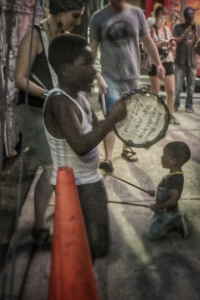 Couple on the elevator, both wearing shirts that say, “Larry’s Rockin’ New Orleans 41st Birthday!”
Couple on the elevator, both wearing shirts that say, “Larry’s Rockin’ New Orleans 41st Birthday!”
Bill to the guy: “Are you Larry?”
Woman (vehement): “No, No, no, no. Oh no. No way.”
Man (annoyed): “He said, ‘Are you Larry?’ not ‘Are you married?'”
Woman and Bill (simultaneous): “Ohhhh…”
What we’ve been doing: We took a Greyline tour to get an overview of the city. We like to do that we first get somewhere and in this case, particularly, so Bill knows where he wants to explore farther and take photos while I’m at the conference. Also, AC on the bus.
 Saturday night a friend of Bill’s who lives here invited us to a concert called “From NOLA with Love,” local musicians coming together to raise funds for flood victims in Baton Rouge and its environs. We saw six fantastic bands, each one better than the one before it, and it was touching to the point of choking up as the musicians talked about doing for Baton Rouge as Baton Rouge had done for them eleven years ago.
Saturday night a friend of Bill’s who lives here invited us to a concert called “From NOLA with Love,” local musicians coming together to raise funds for flood victims in Baton Rouge and its environs. We saw six fantastic bands, each one better than the one before it, and it was touching to the point of choking up as the musicians talked about doing for Baton Rouge as Baton Rouge had done for them eleven years ago.
 Sunday we took a riverboat ride, had brunch and listened to Dixie Land. Very touristy, but I realized I hadn’t been on the Mississippi in thirty years. It was wonderful to see a busy, working waterfront. Also, AC in the dining room and cooling river breezes on deck.
Sunday we took a riverboat ride, had brunch and listened to Dixie Land. Very touristy, but I realized I hadn’t been on the Mississippi in thirty years. It was wonderful to see a busy, working waterfront. Also, AC in the dining room and cooling river breezes on deck.
Other than that, we’ve walked around a lot and we haven’t had a bad meal, including the Cuban sandwich Bill bought me off a truck at the concert.
Can’t wait to see you all! I’ll be the one with hat-head, sun goop in her hair, and perspiring. But then, so will you!
[All photos in this post are by Bill Carito. If you like them and want to see more, you can friend him on Facebook at https://www.facebook.com/bcarito and follow him on Instagram at billcarito and bill.carito.colorphotos.]
Save
Save
Save
Save
Save
Save
Save
Save
Save
Save
Filed under: Barb's posts Tagged: bouchercon, Cozy & Proud, From NOLA with Love, New Orleans Marriott, Raiders, Saints

August 29, 2016
An Unexpected Accessory: And a Giveaway
by Barb, just back from a beautiful week at the Jersey shore and headed back to Maine
I love it when serendipity happens. Don’t you?
Back in July, Liz Mugavero started a Wicked Wednesday thread here on the blog titled, “What’s in your Character’s Purse?”
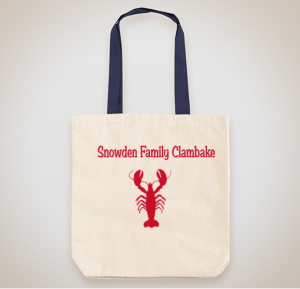 I really liked the question, because it was one of those things I had thought about without thinking about it, you know? The question of what my main character Julia Snowden would use as a purse had come up in Clammed Up, the first book in the series. I decided Julia would throw the things she had to carry around with her in an old Snowden Family Clambake tote bag. Julia’s mother Jacqueline had run the gift shop at the clambake for many years, and it seemed natural the shop would offer such a thing.
I really liked the question, because it was one of those things I had thought about without thinking about it, you know? The question of what my main character Julia Snowden would use as a purse had come up in Clammed Up, the first book in the series. I decided Julia would throw the things she had to carry around with her in an old Snowden Family Clambake tote bag. Julia’s mother Jacqueline had run the gift shop at the clambake for many years, and it seemed natural the shop would offer such a thing.
I thought it would be fun if there was a picture of the tote bag for the blog. So I went on a site that offered custom printed bags and I designed one. Just for the photo, for the blog, mind you. I wasn’t going to order any. I didn’t even price them.
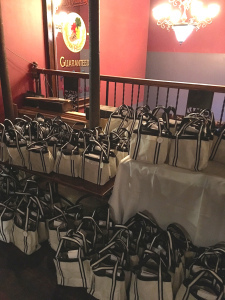 Why did I know where to find such a thing, you ask? Because for my daughter’s wedding the welcome bags were little, tiny L.L. Bean-style tote bags, which felt appropriate to Maine.
Why did I know where to find such a thing, you ask? Because for my daughter’s wedding the welcome bags were little, tiny L.L. Bean-style tote bags, which felt appropriate to Maine.
But Liz hadn’t just asked what the character’s purse was, she’d asked what was IN the purse. That gave me pause. I have always been a purse minimalist. When my kids were young, I used to joke, “I am the mother who never carries tissues.” Or Bandaids. Or chapstick. Or photos of her kids.
I think this is because I am an accessories minimalist generally. I have enough trouble keeping track of the essentials, believe me. When I was in seventh grade, the first year I carried a purse to school, everyday the period after my study hall there was an announcement on the PA. “Barbara Ross, please come to the office.” And then I would realize I’d left my handbag hanging off the back of a chair in the auditorium. Every. Single. Day. My husband would tell you this behavior now extends to my reading glasses, my car keys and my phone. He would be exaggerating when he said this. But not very much.
Over the course of the series, Julia has carried some mundane things in the tote bag, like Snowden Family Clambake brochures (Clammed Up) or her mother’s mail, fetched from the post office (Iced Under). She’s also carried some mystery clues, like a copy of an old photo and an insurance report (Fogged Inn) or a priceless diamond necklace (Iced Under).
But what does Julia carry everyday? I decided she was a little less minimalist than me, and gave her “a nylon wallet, sunblock or chapstick depending on the season, a bundle of covered rubber bands to pull back her hair if she’s on a boat or around food prep, and her smartphone, which works pretty well in Maine, except where it doesn’t.” Not a lot of stuff really. I can also imagine a paperback book and a toothbrush and toothpaste in a plastic holder, a hairbrush, business cards, pens and a small notebook.
 After I designed that tote bag for the blog, I couldn’t get it out of my head. So I decided to order some for real to use for contests and such.
After I designed that tote bag for the blog, I couldn’t get it out of my head. So I decided to order some for real to use for contests and such.
So that’s what I’m offering, dear readers. If you comment on this blog post before noon on September 1, you’ll be entered in a contest to win your very own Snowden Family Clambake tote, along with an Advanced Reader Copy of Eggnog Murder, the collection of three holiday novellas by Leslie Meier, Lee Hollis and me to be published October 25th.
Good luck!
Save
Save
Save
Save
Save
Filed under: Barb's posts Tagged: clammed up, Eggnog Murder, Fogged inn, Iced Under, Snowden Family Clambake, tote bag, wedding welcome bags

July 11, 2016
Just Enjoy the Pretty
by Barb on the chilly Maine coast
Hi Gang. I’m off to Monhegan Island overnight. (Don’t worry. I’ll take plenty of pictures and tell you all about it.)
Like most Americans, I’ve had a severe case of weltschmerz since last week. So since I previously brought up my daughter’s wedding, I’m going to leave you with some pretty photos to contemplate. Look at the families and the friends. Look at the children. Look at the love. And be hopeful.
All photos by the amazing Abby Lorenz.
Filed under: Barb's posts Tagged: #idodonius, 111 Main Catering, Abby Lorenz Photography, Amy Kuschel Lennon, Daisies and Pearls, portland maine, the portland company, wedding

June 13, 2016
To Build a House
by Barb, in Boothbay Harbor, Maine, where the beautiful weekend weather has turned cold and gray
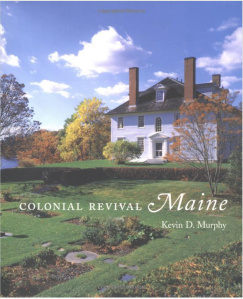 I turned in the manuscript for Iced Under, the fifth Maine Clambake Mystery, in May. When I first proposed, and Kensington bought, books 4-6, I pictured all three books taking place during the off-season in my coastal resort town. But then I had a chance to write a holiday novella for the collection Eggnog Murder, and that meant I had written three off-season stories. I didn’t know how my readers would feel after reading them, but I was ready for sunshine and clambakes and trips to Morrow Island. I suggested to my editor that we ditch my proposed book six and he agreed. (Though I still love the premise, so in my mind, I’m not ditching it. I’m saving it for another time.) So that has left me footloose and fancy-free for the next book. Or should I say, screw-loose and plot-free?
I turned in the manuscript for Iced Under, the fifth Maine Clambake Mystery, in May. When I first proposed, and Kensington bought, books 4-6, I pictured all three books taking place during the off-season in my coastal resort town. But then I had a chance to write a holiday novella for the collection Eggnog Murder, and that meant I had written three off-season stories. I didn’t know how my readers would feel after reading them, but I was ready for sunshine and clambakes and trips to Morrow Island. I suggested to my editor that we ditch my proposed book six and he agreed. (Though I still love the premise, so in my mind, I’m not ditching it. I’m saving it for another time.) So that has left me footloose and fancy-free for the next book. Or should I say, screw-loose and plot-free?
 One thing I know will happen in the next book is that renovations on Windsholme, the empty and damaged mansion on Morrow Island, will begin. The mansion’s been a part of the island landscape from the first scene in the first book, Clammed Up. And in Iced Under, we learn more about Julia’s mother’s family–like who built the mansion and when. But now that I’m renovating, I need to know a lot more about the house itself. We know it was built in 1880, but is it Queen Anne, or Shingle Style or New American Colonial?
One thing I know will happen in the next book is that renovations on Windsholme, the empty and damaged mansion on Morrow Island, will begin. The mansion’s been a part of the island landscape from the first scene in the first book, Clammed Up. And in Iced Under, we learn more about Julia’s mother’s family–like who built the mansion and when. But now that I’m renovating, I need to know a lot more about the house itself. We know it was built in 1880, but is it Queen Anne, or Shingle Style or New American Colonial?
(For the mansion that appears on my bookmarks and website banner, I told the artist to use the inspiration of Edith Wharton’s house in the Berkshires, The Mount. That turns out to be a little too recent for Windsholme.)
 I make sure the research I do for the clambake books is about subjects that interest me, but I have hit the jackpot with this book. I have always loved houses. When I played with my Barbies, I was more interested in the “set ups”–the apartments we created in the bookshelves and toy boxes, than in the melodramatic plotlines that inevitably resulted from having too few Ken dolls to go around.
I make sure the research I do for the clambake books is about subjects that interest me, but I have hit the jackpot with this book. I have always loved houses. When I played with my Barbies, I was more interested in the “set ups”–the apartments we created in the bookshelves and toy boxes, than in the melodramatic plotlines that inevitably resulted from having too few Ken dolls to go around.
 I have to work not to over-describe the houses my characters live in and visit. “Is the protagonist an architect?” a member of my critique group once inquired, way too politely, after my narrator had gone on and on and on about some building or another.
I have to work not to over-describe the houses my characters live in and visit. “Is the protagonist an architect?” a member of my critique group once inquired, way too politely, after my narrator had gone on and on and on about some building or another.
But for now, I am happily surrounded by house porn, researching away. If you’re looking for me, I’ll be on the front porch with a big book on my lap.
Readers: Do you love houses, or could you care less? Do you envy me with all these big books full of houses on my lap, or is that your idea of bor-ing?
Filed under: Barb's posts Tagged: maine old home renovation research
























